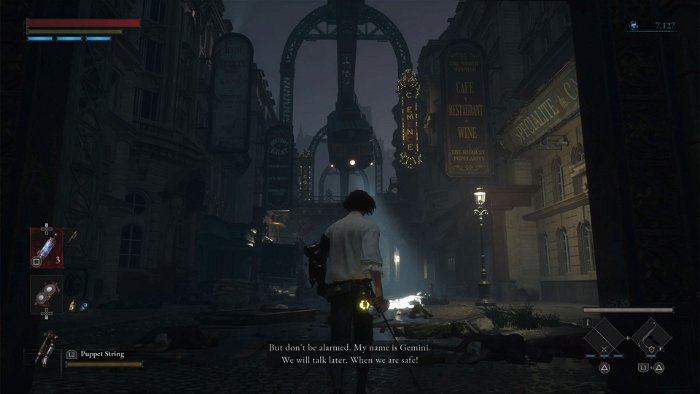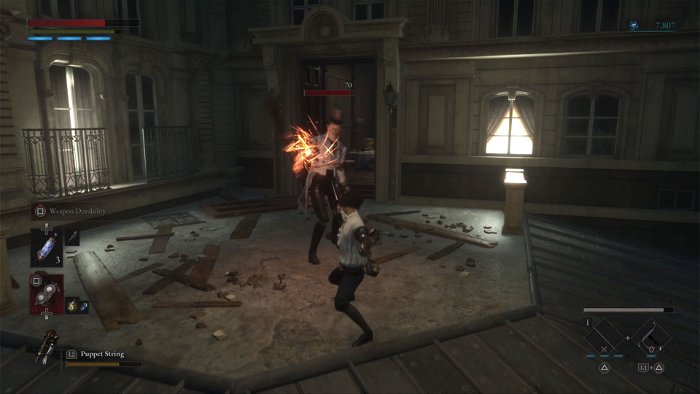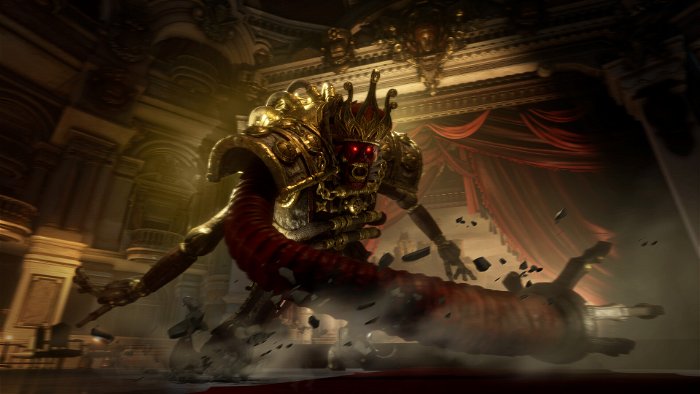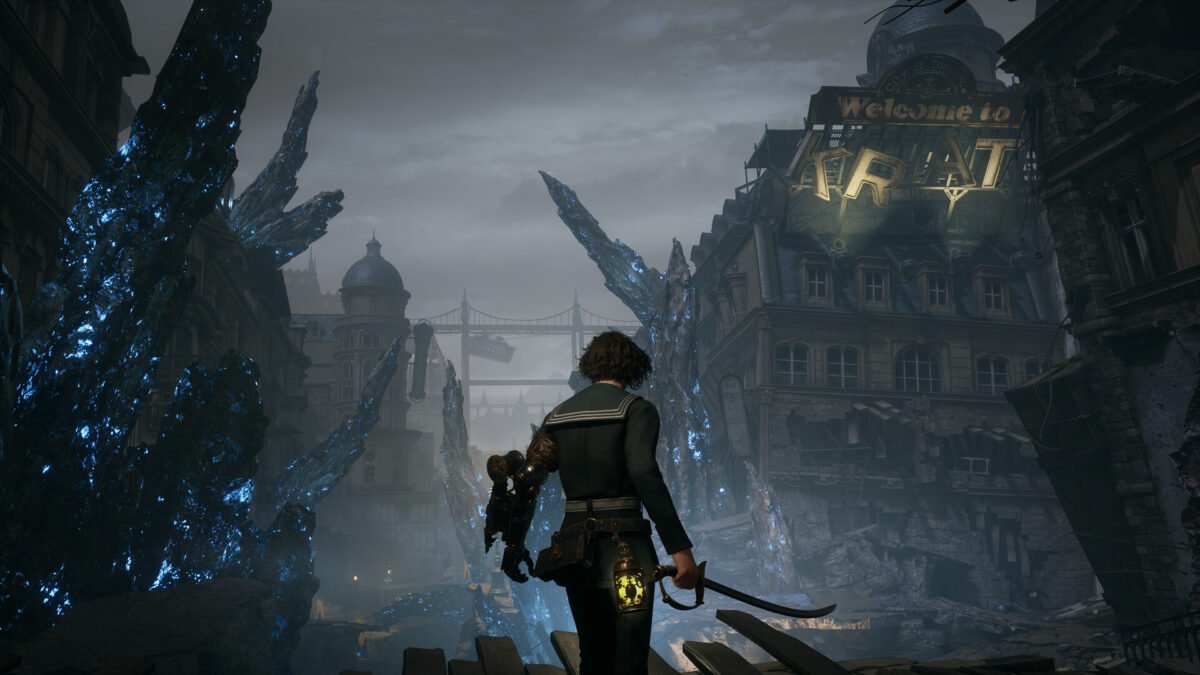I’ve mentioned time and time again on this site that Bloodborne is one of my favourite games of all time, which is why I was so excited to try Lies of P. Bloodborne was the game that sparked my love of the SoulsBorne series, and while From Software has released a plethora of excellent games since 2015, I’ve long been waiting for a chance to take a second trip through Yharnam—or an adjacent land.
This is why I was so immediately sold on Lies of P. So many Soulslikes stick with the Fantasy setting, and so few have attempted the pseudo-Lovecraftian, Victorian setting of Bloodborne. Furthermore, a game so closely resembling Bloodborne where you play as Pinocchio? What more could you possibly want? But outside some comical observations, Lies of P genuinely stands as a brilliant game that adapts its inspirations beautifully and forges its own identity in unique ways.

Lies of P takes place in the land of Krat, whereupon the discovery of a mysterious substance named Ergo saw an industrial revolution, marked particularly by the creation of robotic servants created by the visionary puppet-maker Geppeto. However, after years of prosperity, Krat is thrown into chaos when the puppets suddenly turn violent—dubbed the “Puppet Frenzy”. At the same time, citizens are also under the curse of the “Petrification Disease,” which causes hard scales to form over their bodies and turn them to stone…or worse.
In the midst of the madness, a special puppet referred to simply as “P,” awakens in Krat’s train station—made to look human and gifted with incredible strength. P must fight his way through Krat in order to seek answers about his creation, and possibly free the city from the terrible curse it has been put under.
“…Lies of P genuinely stands as a brilliant game that adapts its inspirations beautifully and forges its own identity in unique ways.”
It is both a unique reimagining of the story of Pinocchio—drawing more from the book itself than the more popularized Disney film—and an excellent adaptation of SoulsBorne lore, clearly being more inspired by Bloodborne. And though the developers may not have intended to invoke similarities to Bloodborne, they certainly are there. However, I have said in the past that games deriving ideas from others is by no means a bad thing.
While you can see the similarities, Lies of P’s story feels so uniquely its own, borrowing familiar concepts and characters from the novel, and adding tremendous amounts of mystery, sorrow and otherworldly elements to them. In a lot of ways, The Adventures of Pinocchio is perfectly suited to From’s iconic style of storytelling and theming—being centred around the ideas of death and rebirth, loss of innocence and the human condition. In that way, Lies of P perfectly captures what makes both of the things that inspired it so special.

Gameplay in Lies of P is equally inspired by the SoulsBorne series, while still finding subtle ways to set itself apart. Players will explore the various areas of Krat while cutting through any puppets or creatures that stand in their way. In traditional SoulsBorne fashion, this typically means locking onto and facing each enemy one by one—making sure to keep an eye on your health and, most importantly, stamina in order to survive.
In truth, Lies of P borrows from Dark Souls, Bloodborne, and a little bit from Sekiro: Shadows Die Twice, and while the game could have simply adapted traditional SoulsBorne combat competently enough to make an enjoyable game, it finds ways to incorporate so many elements from multiple From Software games, and put its own spin on them. For example, much like how Bloodborne implemented a system wherein players could restore health by attacking enemies, Lies of P has a similar system where damage taken from blocking can be restored by dealing damage to enemies—obviously, unblocked damage is non-recoverable.
“This wide array of ways to approach combat arguably makes Lies of P one of the most approachable Soulslikes to date…”
Lies of P also utilizes a perfect block/parry system, not unlike Sekiro: Shadows Die Twice, where timing your blocks perfectly will result in an enemy becoming staggerable, and a charged attack can leave them open to a Fatal Attack (but this can still be achieved through a classic backstab). This wide array of ways to approach combat arguably makes Lies of P one of the most approachable Soulslikes to date, and while the game is by no means a tiptoe through the tulips, I never felt as though it was so challenging that it bordered on frustrating.
Outside the fundamental Soulsborne combat, P is equipped with a “Legion Arm,” which like The Wolf in Sekiro, can be equipped with different tools that can assist in combat. The “Puppet String” can pull enemies close to P for an immediate advantage in a fight, while Fulminis allows P to release a charged electrical attack, which is devastating to puppets. Each arm has different extra abilities which can be unlocked by upgrading with specific parts.

But that’s not the only way Lies of P shakes up its combat. The game approaches weapons in a way that is similar to its SoulsBorne inspiration, but unique in its own right. Much like the games that inspired it, Lies of P’s weapons scale with different stats—Motivity which I think is essentially Strength; Technique which is basically Dexterity, and Advance which is more or less Bloodtinge. However, weapons are split into two parts: the blade and the handle. When players find new weapons, they can break them down in order to make different combinations to varying effects.
While this can change how a weapon attacks and scales, since those stats are relegated to the handle itself; it can also change the weapons Fable Arts which—not unlike Elden Ring’s Ashes of War—are special abilities that can give P a unique edge in combat. And since both the handle and the blade have individual Fable Arts, there are a lot of interesting combinations players can experiment with.
“Visually, Lies of P is stunning.”
Finally, Lies of P adds to its RPG elements by giving P a simple skill tree that can be unlocked after reaching a certain point in the game. Named the P-Organ, it takes the form of P’s mechanical heart, and by spending Quartz, players can unlock added perks by attaching certain buffs to them. Once enough of the perks have been opened, the next phase becomes available, giving players more power and abilities.
But of course, there are the titular “Lies” of P that make up a core component of the gameplay. During certain story points in the game, P will have the ability to lie in order to progress. Unfortunately, given my limited time to review Lies of P, I cannot say for sure what lying does for certain. Initially, I assumed it would be a sort of moral choice system, as every lie gives you the text, “your springs are reacting,” however other elements of the game, like listening to music on the in-game jukebox have yielded that result. It may affect what items you can receive from sidequests, and it may very well affect the way the game progresses or ends, but I cannot say for certain. All I can say for sure is it is an interesting element that I am excited to see play out with more time.

Also, special mention has to be made for the way Lies of P treats dropping all your Ergo upon death, particularly in boss fights. Something that’s always bothered me in the SoulsBorne games is how, if you die during a boss fight, all of your EXP is dropped in the boss room and is essentially unobtainable unless you can finish the boss. This can be particularly frustrating if you went into a boss with a large amount of Souls/Echoes/Ergo and can no longer use it to level up to gain an advantage on the boss—needing to do a particular amount of grinding in order to proceed.
But Lies of P has thought well ahead of such a problem, now placing any Ergo dropped during a boss fight OUTSIDE the boss room. It’s such an obvious solution, and yet no one has done it—whether out of adherence to the old laws or to manufacture the illusion of challenge. It’s just one of the myriad ways Lies of P not only adapts the SoulsBorne formula but enhances it as well for a truly accessible experience.
And there are so many other ways Lies of P finds a way to take elements from the SoulsBorne games but go its own way with them. P heals himself with Pulse Charges (which are essentially Estus Flasks)but after you run out, dealing damage to an enemy can refill one charge—however, this is limited to one charge, and will only fill once empty. Weapons have durability, but P is equipped with a sharpening device—which is in his mechanical arm and looks really badass when he does it—and only if a weapon’s durability reaches zero does it have to be taken to a shop.
Special items are given an indicator on warp points to let you know where to use them—though finding where they need to be used specifically is still up to the player. I can go on and on, but I think you get the idea; Lies of P isn’t content to just utilize solid gameplay elements from its inspiration, and in almost every way it has found a way to build on them and differentiate itself.
Furthermore, Lies of P has a bit more of a straightforward level design which I actually really enjoy. Don’t get me wrong, I love the huge worlds the SoulsBorne games are able to create, and finding shortcuts to get around is a big part of the strategy. But Lies of P—while having a lot of those elements—feels a lot more linear in its design and evokes a bygone era of intense ARPGs gone by. In a way, it reminds me a bit of Nightmare Creatures, which was another game that had incredibly tight combat on a level-to-level basis, and it feels a bit more arcadey and more approachable in that way.

However, it’s not a completely flawless experience. There is a degree of stiffness to the controls, particularly in dodging, that makes the combat feel a bit restrictive. I’m not totally sure if it’s just me, but it’s a way that feels like you can’t dodge until P completely finishes an attack animation, so you’re unable to cancel out of an attack or get away quickly. I played Bloodborne for comparison while reviewing this, and while you can’t dodge mid-attack, it kind of feels like in the true SoulsBorne games, dodges come out a lot faster. Also, on more than one occasion I got stuck on the level geometry or an opponent themselves, resulting in some cheap deaths.
Visually, Lies of P is stunning. Although not totally perfect—I have noticed some moments of texture pop in—the world of Krat is bleak, harrowing, and intensely beautiful. The way its Victorian-style architecture looms over you, creating a labyrinth of cobblestone and steel, is always awe-inspiring and suspenseful, and you explore narrow alleyways and overwhelming factories.
“…Lies of P has a bit more of a straightforward level design which I actually really enjoy.”
Enemies are equally interesting. While not as varied as some of the inhabitants of Dark Souls or Bloodborne, the stilted, mechanical movements of the puppets always feel creepy and constantly keep you on edge. As the game progresses, you do start to see more variety from lumbering giant puppets to eerie destroyed dolls, and even standard puppet frames that don’t stagger or make noise which is genuinely off-putting.
Bosses too can range from immense and terrifying, to the more nimble Hunter-type characters that feel more like PVP fights. Each one typically has two forms once they get to about half-health and will keep you on your toes and demand you start learning their telegraphs unless you wish to be beaten into a puppet pulp.

The audio is equally fantastic. Though most of the game utilizes the subtle ambiance of a city devoid of life, boss music is bombastic and intense, perfectly suiting each fight. The sounds of puppets clanking through the streets, voice boxes glitching and gears grinding add so much life to these otherwise lifeless opponents. There’s even a strange effect where characters have a degree of reverb on their voice, which I’m sure could be considered an audio glitch, just adds more mystery to the world—like who is a puppet pretending to be human, and who isn’t?
Lies of P may not be Bloodborne 2, nor was it ever trying to be, and to say it’s the game to tide you over until we get a true sequel to Bloodborne feels like a massive disservice to the incredible game that it is. It is a worthy addition to the pantheon of incredible Soulslikes and in the same way I fell in love with Bloodborne only moments after playing it, I’ve fallen in love with Lies of P. It does everything right, minus a few technical hiccups, and carves a name for itself wholly its own. I’d say imitation is the sincerest form of flattery, but this isn’t imitation—this is elevation.






